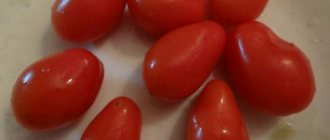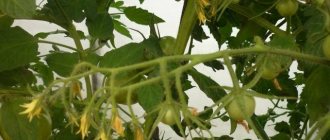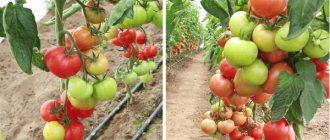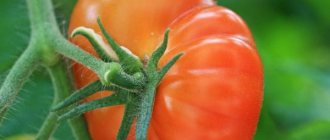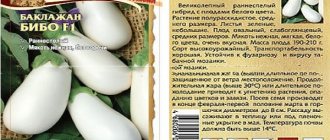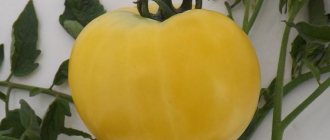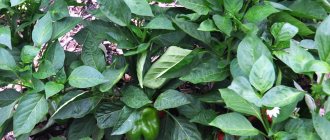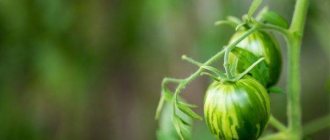Description of the variety
Fruit:
- They consist of several small tomatoes (from 5 to 12 fruits), which have one partition, which is why they look like a garlic head;
- With dense, juicy, sweetish-sour pulp;
- Ripe tomatoes are red in color;
- The number of chambers in each lobe is from 3 to 6 pieces, with small, few seeds;
- The average weight varies from 90 to 100 grams, but some specimens reach 120-300 grams.
Review from a gardener:
Bushes:
- Tall, non-standard, indeterminate plant;
- Has unlimited growth, grows up to two meters in height;
- The length of the leaves reaches 15 cm along the central vein.
Pests and diseases
As already stated, Reisetomates are rarely affected by disease. Most plant damage comes from the effects of whiteflies and spider mites.
The fight against these insects comes down to setting traps, as well as using traditional methods. For example, kutas can be irrigated with a soap solution.
If this is not enough, it is recommended to use the drugs Actellik and Fitoverm. Three weeks after application, the treatment should be repeated.
Reisetomates are unusual, exclusive tomatoes that can surprise you so much with their appearance that you’ll want to grow them in your garden yourself. There is not a single tomato on the plants that is similar to another. By all measures, these tomatoes are one of the most amazing in the world.
Growing tomatoes
Garlic tomatoes can be grown both in open ground and in greenhouse conditions.
How to prepare seeds?
Basic rules for preparing seed material:
- Pre-sowing disinfection of seeds is carried out in order to improve their sowing characteristics and accelerate the emergence of friendly shoots;
- Dry full-bodied tomato seeds are heated using variable temperature conditions: 48 hours - about +30 °C, and another 72 hours - at +50 °C;
- Before sowing, pre-soak in a weak manganese solution for half an hour. The seed is then washed under running water for about 10 minutes.
Sowing seed material
Recommendations for proper sowing of seeds:
- Plastic containers and seedling cassettes are suitable for growing seedlings. All selected containers must be disinfected before sowing seeds;
- You can sow in any universal ready-made substrate, or prepare a soil mixture yourself from equal parts of sand and peat;
- Seeds are sown in mid-March;
- Bury the seeds 1 cm into the soil. Do not sow too thickly, this will lead to the seedlings being stretched out;
- Plantings must be covered with film to speed up the process of shoot germination;
- Until the first shoots appear, a temperature regime of +23 ºС is required. As soon as they appear, the film is completely removed;
- To avoid flooding of seedlings for watering, it is better to use a spray bottle;
- It is also necessary to observe the temperature regime: after the first shoots appear, the temperature is lowered to +8 °C...+10 °C at night and +10 °C...+15 during the day - for three days.
REFERENCE: This will allow you to harden the seedlings from the first days of their growth. Hardening continues until the seedlings are planted in a permanent place.
Rules for planting seedlings
How to plant seedlings correctly:
- Tomato seedlings are planted after June 10, after the danger of returning night frosts has passed;
- Before planting in the garden bed, make planting holes, which are thoroughly watered (at the rate of one liter per hole), and the hole itself is sprinkled with dry soil;
- The row spacing should be from 30 to 50 cm, the interval between tomato bushes should be 30-40 cm;
- Sprinkle the seedlings with dry soil and water them.
Formation and stepsoning
This unusual variety has the ability to grow a huge number of stepsons. Their growth does not stop even in autumn. If they are not broken off, the plant can take over the entire space of the greenhouse, while the yield will be very low.
What does the formation of tomatoes give:
- Productivity increases.
- The fruits grow larger and juicier.
- The fruits ripen faster.
- Nutrition goes directly to the fruits, and not to useless branches.
- The risk of fungal infection is reduced.
- Caring for such a plant is much easier.
Forming tomatoes into three stems is the key to a high yield. The formation of a Reisetomate is mandatory. If you manage your plants correctly, you can collect up to ten kilograms of delicious exotic fruits from one bush!
The first side shoots begin to grow even at the earliest stage of development of young plants. Already two weeks after planting in the ground, you need to make the first stepson, breaking off all useless shoots. Then this procedure must be performed every 10-12 days.
The easiest way to form tomatoes is in one stem. The point is that all the side shoots are broken off, leaving only the central trunk on which the clusters are formed.
When bushes are formed into two or more stems, all the stepsons break off, with the exception of one or two, which are found under the first and second inflorescences. They will continue to grow and acquire their own clusters, on which fruits will later form. Keeping plants with more than one stem requires additional garters. However, there is a plus - the bushes will not grow up so rapidly.
Bush care
Necessary measures for further care of garlic tomatoes:
- To avoid possible breaking of the stems under its own weight, the tomato is tied to a trellis;
- Loosen the soil between the rows and bushes. The procedure is carried out every 10-12 days. When growing tomatoes on heavy soil, you need to deeply loosen them in the first 10-15 days after planting the seedlings;
- The first hilling is carried out 9-11 days after planting the seedlings;
- Carry out timely watering of plantings, at the rate of 0.7-0.9 liters per bush. It is better to water in the afternoon and in cloudy weather. It is necessary to water during the flowering of the first and second clusters, before loosening, and also after applying dry mineral fertilizers;
- During the entire growing season, fertilizing is carried out using mineral and organic fertilizers.
ATTENTION: Before hilling, be sure to water the soil; moist soil will accelerate the formation of new roots on the stem. The second time they hill up 16-20 days after the first.
Watering
One of the important aspects of caring for a tall variety is proper watering. Indents like to drink a lot, but rarely. In cloudy weather, the bushes are watered once a week. During dry periods - 3-4 times a week. Tall bushes are watered only at the root, trying not to touch either the leaves or the stem with water. Dry foliage will not become infected with anything and will not rot, which will protect the plants from various ailments associated with insects and putrefactive diseases.
Note:
Water the tomatoes only with warm, settled water. Water from under the hose can inhibit plant growth.
Often, especially in a greenhouse, water stagnates on the surface. This means that the ground under the bushes has become too compacted. Because of this, moisture and fresh air do not reach the depths, and the plant thereby does not receive sufficient nutrition. Loosening will help save the situation, or you can make several deep punctures in the ground with a pitchfork.
Advice:
For such a giant as Reisetomate, regular watering is important. If this is done untimely and at different time intervals, the fruits become smaller and crack.
Reviews about the variety from those who planted
All gardeners who love exotic things speak only positively about the garlic tomato, due to its high resistance to diseases and insect pests, as well as the unpretentiousness of the tomato crop.
The garlic tomato will perfectly decorate both a greenhouse structure and beds in a home garden. It will surprise even experienced gardeners with its unusual appearance. This exotic variety is quite easy to grow, and you can use independently collected material for further planting.
Reviews
Reisetomate is a very tall tomato variety with unusual fruits. It produces so many stepchildren that I often don’t have time to process them. I grew it in a greenhouse - it grew almost four meters, with three stems. The bushes are very powerful, persistent, spreading, bush-like. The fruits look like fused cherry tomatoes. Easily separated from each other. This tomato variety has other names: garlic, brain tomato, traveler's tomato. In fact, everything unusual in this variety appears only externally. The taste is like ordinary mediocre tomatoes, which, for example, do not reveal their taste when preserved. But they have a lot of juice, so it will be good for juices and tomatoes. The first fruits ripened early, in early July. The last ones were filmed in early October. A very productive variety.
I planted Reisetomate once, out of curiosity. What can we say, an interesting and unusual tomato, unique. You need to get used to its taste. It bore fruit in the greenhouse until the fall, the bushes did not suffer from anything, and a lot of fruit was produced. I didn’t pinch the top; I was curious to know how long the bush would grow. And he will continue to grow and grow. There wasn’t much trouble with it, but overall I didn’t like this variety. Neither the taste of tomatoes, nor their shape, nor the tomato plant itself - somehow there is too much of everything. I won’t be planting it this year for sure.
Read also Alpinia officinalis 6 letters hint for
I had experience growing this tomato. Only I bought it under the name “Garlic”. In open ground the bushes were slightly higher than a meter. There are a lot of ovaries. A very productive variety, unpretentious. The fruits have an interesting shape - one giant tomato consists of a dozen fused tomatoes. But the taste is ordinary, nothing memorable. I also didn’t like the fact that these tomatoes are very difficult to cut, that is, you can’t make a normal cut, you can’t put them in a jar. I used the Garlic harvest for juice. Although it turned out not so fragrant and juicy.
I have been planting Reisetomate tomatoes for several years. I really like these tomatoes. And I think the taste is quite good. The pulp is very juicy, fleshy, soft, with a slight sourness. I removed 4 kilograms from one bush. The weight of each tomato is 300 grams. In general, I have planted and will continue to plant. And I recommend everyone to try this variety, at least for the sake of experimentation.
Exotic tomato varieties with unusual shapes and colors can be found quite rarely in Russian garden plots. However, even they cannot be compared with the tomato, whose homeland various sources consider either Transylvania or Guatemala. Garlic tomato has other names: Reistomat, Zehen and Traveler from Transylvania.
Tomato variety "Garlic":
Reviews from those who planted
Marina from the Krasnodar Territory shares her growing experience:
“The variety attracted me with the unusual appearance of the fruit. After planting, it immediately began to produce a large number of shoots, the branches were spreading, so I removed everything. I left only the 3 tallest branches. At the beginning of July I already harvested my first harvest. Basically the taste is good, but weakly expressed. There’s a lot of juice, the tomatoes are suitable for canning and for making tomato paste.”
“I raised Reisetomate in a heifer for 2 years in a row. Fruiting lasted until October, immediately after the bush began to stretch, I pinched the top, so there were no overgrown plants. The variety is easy to care for; all the seedlings quickly took root and began to grow. The shape of tomatoes is unusual, unattractive, they can only be cut into salads or used in cooking.”
Read also Vibrating potato digger for Neva walk-behind tractor
It seems that modern gardeners can no longer be surprised by anything. However, breeders still try their best and each time create more and more unusual varieties of tomatoes. Similar varieties include the Reisetomate tomato.
It produces unique fruits that are shaped like flowers.
Striped tomato varieties photo
Dacha » Vegetable garden
Cylindrical-shaped tomato fruits are good for whole-fruit canning; they are convenient to place with cucumbers; besides, jars with elongated tomatoes look impressive.
Scarlet candles
Indet for greenhouses, included in the State Register as a pickling and salad plant. Seemed medium late to me. The skin is a bit thick for salad, but just right for pickling. They look beautiful on a bush. They are susceptible to blossom end rot and do not tolerate shading or overwatering.
Nadya Photos
Nadya Photos
Switter Giant
A rare pickling variety from the USA, indet, for greenhouses and open ground.
Photo by Varvara Plyushkin : “A good meaty tomato. It tastes sweet."
Photo by Varvara Plyushkin . The Switter Giant.
Gulliver
This is a tomato for open ground and greenhouses, but in Siberian conditions it is preferable to grow it indoors, although it is determinant. High-yielding, drought-resistant, tolerates cold well.
Included in the State Register as salad, canning and intended for the production of tomato products (tomato paste, for example). Mirage : “I’ll add about Gulliver tomatoes.” They are so abundant that they tear the garters and fall to the ground. Probably a kilogram on one branch. And there are five branches.
The fruits have grown very quickly. Very convenient for preservation. I want to try making sun-dried tomatoes out of them when they’re ripe.”
cherry76: “We plant Gulliver tomatoes, there are a lot of them on the bush: large, oblong, and the bushes are small - about 50-60 cm.”
Jersey Devil
Indet for greenhouses, an old variety from the USA. The skin is dense, does not crack, the wall is thick. Aulchanka : “My Jersey Devil was not bad, but my neighbor’s was simply magnificent - large, elongated fruits, sweet, I will plant them. The shape is elongated with a pointed tip.”
Jersey Devil
Laura
High-yielding indet for greenhouses and open ground, included in the State Register, recommended for salad use. Varvara Plyushkina : “The Laura variety is intended for greenhouses. I planted it in a greenhouse, the rest, 5 of them, went outside. The plant itself, while growing, had an eerie appearance - skinny, scary, very elongated, with tiny brushes.
I was about to tear it out, but something stopped me. I decided to see what would grow. The results turned out to be quite good fruits, red, dense, elongated, sweet, good for pickling. On the street the bushes turned out to be small, the fruits are only on the lower tier, the fruits themselves are small.
Well, in the greenhouse I’ve already tied it to the ceiling, 8-9 clusters are blooming and forming there, as I understand it, they can produce tomatoes until frost.”
Photo by Varvara Plyushkin
Photo by Varvara Plyushkin
Moscow delicacy
High-yielding indet for salad purposes (according to the recommendation of the State Register) for greenhouses and open ground.
Moscow delicacy.
Moscow delicacy striped
This half-indet has not yet been included in the State Register because it is a new product. Very similar to the Pepper Striped.
Niagara
This item is included in the State Register and is recommended for whole-fruit canning. Sveta-nsk : “The widely advertised variety Niagara (Agros) turned out to be completely incomprehensible to me.
It seems that there are quite a lot of tomatoes on it, and they are tasty, but the bush is crooked in all directions, the leaves are always stained with some kind of spots (and around, in the same greenhouse, not a single tomato is sick). And one more minus - not only brown, but even blanzhe (orange) fruits do not ripen normally.
They quickly begin to wrinkle and in some places even become covered with brown spots - not late blight, but some kind of incomprehensible blight, purely external. If you leave the tomato on the root, it ripens normally, but very slowly.
In general, if you grow Niagara, you will have to run around so much - pinching, straightening, treating and waiting for the red fruits on the vine that there will be no time left for the rest of the garden.”
Niagara. Sveta-nsk Photos
Pepper-shaped
There are 7 varieties included in the State Register, the names of which contain this word:
- Pepper-shaped (salad indet for exhaust gas),
- Pepper-shaped Giant (indet for indoor and open ground, pickling and salad),
- Pepper Yellow (indet for salads for greenhouses and OG, resistant to blossom end and root rot),
- Pepper-shaped Red (salad product for greenhouses and exhaust gas),
- Pepper-shaped Krepysh (early ripening lettuce determinant for OG),
- Pepper Raspberry (determinant for salads, grown both in greenhouses and in greenhouses),
- Pepper-shaped Orange (salad indet for film shelters and exhaust gas, can grow in slight shade). Needlewoman 09: “I really liked the tomatoes - Orange Pepper (Agros). I bought it from the picture and was right: fleshy, sweet, and a lot on the bush. I will plant again this year!” sten212: “Pepper-shaped Orange - tasty, beautiful, fruitful.”
Peppery Orange.
But sibling mothers especially liked the eighth variety, which has not yet been included in the State Register - Pepper-shaped Striped - a semi-indect for salad and pickling purposes for exhaust gases and greenhouses. JuliaZa : “Pepper Striped is delicious, the bushes are compact and productive.”
Pepper Striped in section. Photo by JuliaZa
Photo by JuliaZa
Varvara Plyushkina: “These are striped peppers - very good pickling tomatoes. I've been growing them for many years. Delicious, sweet, sugary, excellent for pickling and simply beautiful. Their appearance is red with yellow stripes. Grown in open ground.
I’ve had this variety for more than 10 years (I ordered it from Ozyory), I’ve been taking my seeds for a long time.”
When pickled, these tomatoes remain striped, and are also very tasty, as La Perouse : “Of the tomatoes, I was pleased with the Striped Pepper, which grew in a greenhouse, there were a lot of them, and I liked the taste in pickles.”
Pepper Striped Bush. Photo by Varvara Plyushkin
Photo by Varvara Plyushkin
Petrusha Ogorodnik
This is a very successful determinant for exhaust gas, because it does not require stepsoning. Included in the State Register as a salad plant. It can be disappointing when grown in a greenhouse, since the fruits are always tastier in open ground than in protected ground.
Flowerfly : “Parsley Ogorodnik - sweet, fleshy!!! I will plant!” Lu: “Petrusha Ogorodnik makes me happy! Thanks to the one who advised here on the forum. Ground, no. Trash gardener. The quality of the fruits is worse than that of Troika, and the yield is lower.
In general, so-so” and Sveta-nsk : “Everyone is good at Parsley Ogorodnik, but for me it always cracked after rains, especially the largest and most beautiful fruits. Our soils are sandy and dry out quickly, which is why tomatoes in exhaust gas react this way to unexpected “water from the sky.”
I suffered with Petrusha for three years and stopped planting.”
Roma
The manufacturer recommends this pickling determinate variety for beginning gardeners, however, sibling Eugene 17 for the Roma variety has a negative review: “Terrible. Determinate, the fruits are elongated, with a very hard skin. They were sick endlessly. First one thing, then another. As a result, what was not affected by crown rot was rotted by late blight.”
Siberian Troika
LaMi : “I’m planting for the second year. Open ground. Determinate, elongated fruits, good in salads and pickled. I liked that the seedlings do not stretch compared to other varieties.” Included in the State Register as canning, salad and whole-fruit canning.
Khokhloma
Indet for greenhouses, included in the State Register, yield up to 9.9 kg/sq.m. Fluffy Pug: “Red, pepper-shaped, medium in taste, very dense, carpal.”
Shuttle
This is an upright standard variety. Included in the State Register as a pickling plant and for whole-fruit canning, susceptible to late blight. Eugene 17: “The shuttle is a determinate bush, low, the fruits are elongated, slightly pointed, productive. I grow it periodically. But this variety has a big disadvantage - the fruits are highly susceptible to blossom end rot.”
Lapwing
Determinate, included in the State Register as a salad and for whole-fruit canning, grows both in greenhouses and in greenhouses. Fluffy Moska : “40-50 cm, doesn’t take steps, tons of fruit.”
Characteristics
The Garlic variety differs from other tomatoes in its very large, uneven fruits, consisting of small cherry tomatoes fused together. It is recommended to use them fresh for preparing vegetable salads and snacks. Such fruits are also good in hot dishes - casseroles, for example. Garlic is not suitable for making juices and marinades due to its too strong acidity.
In greenhouse cultivation, Garlic tomato produces a large yield - at least 8 kg per plant. In open ground, this figure reaches a maximum of 7 kg per bush. Summer residents call the undeniable advantage of the variety its high resistance to diseases and pests, as well as the unpretentiousness of the plant. Among the disadvantages, they mention excessive acidity of the fruit.
You can compare the yield of this variety with others in the table below:
| Variety name | Productivity |
| Garlic | 7-8 kg per bush |
| Crimson Sunset | 14-18 kg per sq.m. |
| Inseparable hearts | 14-16 kg per square meter |
| Watermelon | 4.6-8 kg per sq.m |
| Giant Raspberry | 10 kg per bush |
| Black Heart of Brad | 5-20 kg per bush |
| Crimson Sunset | 14-18 kg per square meter |
| Cosmonaut Volkov | 15-18 kg per sq.m |
| Evpator | up to 40 kg per sq.m |
| Golden domes | 10-13 kg per sq.m |
Read on our website how to properly grow large tomatoes, along with cucumbers, along with peppers, and how to grow good seedlings for this.
And also methods for growing tomatoes in two roots, in bags, without picking, in peat tablets.

